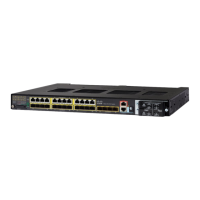907
Configuring IP Unicast Routing
Configuring Protocol-Independent Features
CEF is enabled globally by default. If for some reason it is disabled, you can re-enable it by using the ip cef global
configuration command.
The default configuration is CEF enabled on all Layer 3 interfaces. Entering the no ip route-cache cef interface
configuration command disables CEF for traffic that is being forwarded by software. This command does not affect the
hardware forwarding path. Disabling CEF and using the debug ip packet detail privileged EXEC command can be useful
to debug software-forwarded traffic. To enable CEF on an interface for the software-forwarding path, use the ip
route-cache cef interface configuration command.
Caution: Although the no ip route-cache cef interface configuration command to disable CEF on an interface is
visible in the CLI, we strongly recommend that you do not disable CEF on interfaces except for debugging purposes.
BEFORE YOU BEGIN
Cisco Express Forwarding requires a software image that includes Cisco Express Forwarding and IP routing enabled
on the switch.
If you enable Cisco Express Forwarding and then create an access list that uses the log keyword, the packets that
match the access list are not Cisco Express Forwarding switched. They are process switched. Logging disables
Cisco Express Forwarding.
DETAILED STEPS
EXAMPLE
Switch(config)# ip cef
Switch(config)# interface ethernet 0
Switch(config-if)# ip route-cache cef
Switch(config-if)# end
Command Purpose
1. configure terminal Enter global configuration mode.
2. ip cef Enable CEF operation.
3. interface interface-id Enter interface configuration mode, and specify the
Layer 3 interface to configure.
4. no shutdown Enable the interface if necessary. By default, UNIs and
ENIs are disabled and NNIs are enabled.
5. ip route-cache cef Enable CEF on the interface for software-forwarded
traffic.
6. end Return to privileged EXEC mode.
7. show ip cef Display the CEF status on all interfaces.
8. show cef linecard [detail] Display CEF-related interface information.
9. show cef interface [interface-id] Display detailed CEF information for all interfaces or the
specified interface.
10. show adjacency Display CEF adjacency table information.
11. copy running-config startup-config (Optional) Save your entries in the configuration file.

